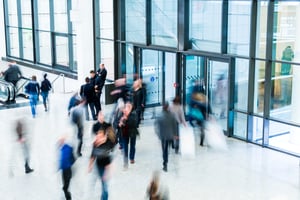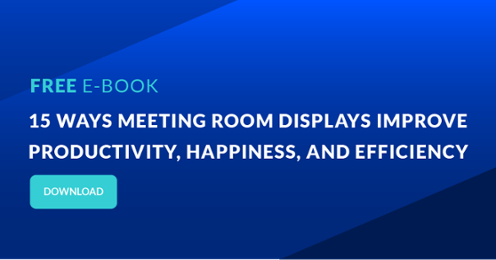What are employees' expectations and preferences, and what to consider as employers plan to return to the office? What does the future of workspace look like from the eyes of employees?
With a global pandemic forcing countries to lock down and companies to enforce work-from-home policies, companies realize that the way we work will drastically change in the long term. The corporate mindset was already shifting, but the pandemic has hastened the realization that work is not somewhere we go but something we do. The crisis accelerates the transformation of work at an incredible pace toward a hybrid work ecosystem, shifting expectations of a liquid workforce who want to continue working from home regularly post-crisis.
Furthermore, the pandemic has accelerated the office's natural evolution away from a productivity space to something else — both a learning space and a space to solve complex problems. As a result, we are at an inflection point where companies are figuring out how to adapt their operating models to the "new normal" and enable their workforce and the workplace to foster collaboration, innovation, productivity, and employee health safety in a post-pandemic world.
The future workspace prediction from employees
But what are employees' expectations and preferences for the workplace and how to carry out work as the roll-out of vaccines globally is happening, and companies can start to generate the back-to-office plan?
In recent research by one of the leading American commercial real estate services companies, JLL, they analyzed employee sentiments of more than 2,000 office workers across ten countries about workforce preferences after COVID-19. The research showed that hybrid work is becoming the new normal and now the preferred way of working. Employees prefer their remote work to double from 1.2 days pre-pandemic, to 2.4 days post-pandemic, and 26% of employees prefer to work exclusively outside of the office.
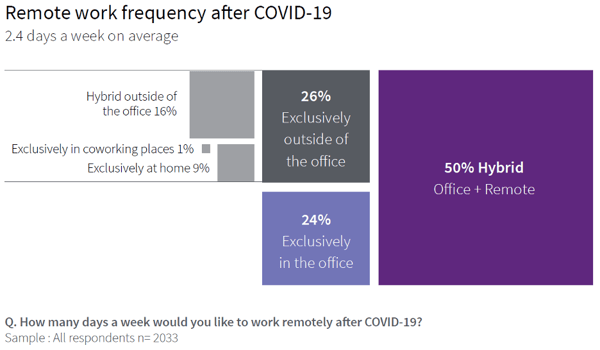
Source: JLL
Work from Home Is Not the Complete Solution
While work from home has become increasingly popular and widely adopted during the global pandemic, it is important to acknowledge that it is not a one-size-fits-all solution for all operational needs and workstyles. While remote work offers flexibility and convenience, it may not be suitable for certain tasks and collaborative activities that require in-person interactions.
3 out of 4 employees still want the ability to come into an office, and 70% of employees find that the office environment is more conducive to solve work-related issues, collaborate and run meetings, and manage or be supported by management. Hence, the office's new purpose has emerged, and the office is evolving into a destination for in-depth collaboration, problem-solving, and career development.
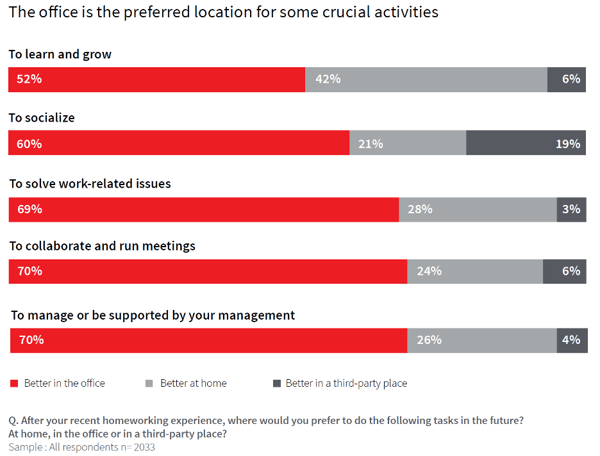
Source: JLL
In addition to the evolving nature of workspaces as social hubs, there is a growing need for dedicated spaces that cater to focused individual work. As the concept of remote work continues to gain popularity, companies must provide private areas within the office that allow employees to concentrate on their tasks without distractions. These spaces should be equipped with the necessary technologies to facilitate seamless collaboration with colleagues who may be working remotely.
Recognizing the importance of maintaining productivity and ensuring effective communication, companies must invest in creating these individual workspaces. By offering quiet and secluded areas within the office, employees can find the balance between remote and in-person collaboration. This not only supports their individual work needs but also promotes a sense of autonomy and flexibility.
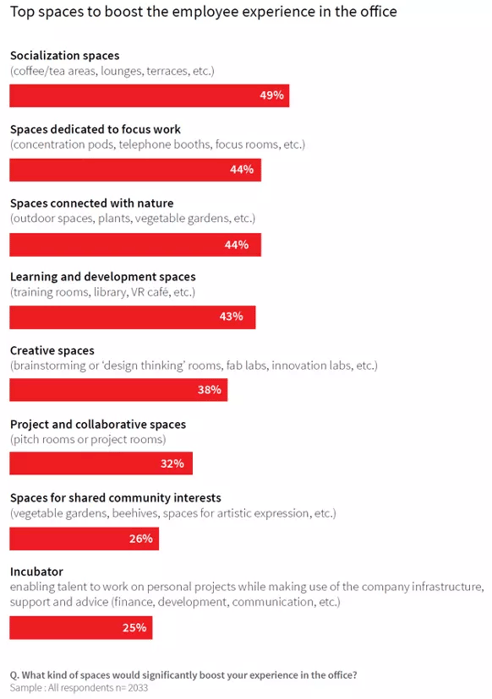
Source: JLL
Space as a Service Will Thrive
To cope with changing employee preferences in a post-pandemic office and world, companies need to rethink space allocation in-depth and promote "Space as a Service" workplace models. To meet new workforce expectations, employers will have to accelerate the switch from providing spaces to support individual work to offer various on-demand areas dedicated to collective needs.
Employees are conscious that a 'new deal' needs to be sealed with their employers: more freedom and choice, and more remote work and diversity in the office in exchange for their individual desk. Today this is becoming a fair and rewarding agreement.
67% of employees would be prepared to switch to a hot-desk environment in exchange for a broader diversity of office spaces and increased access to work-from-home. This trend is even stronger among managers (77%) and young professionals (75%).

Source: JLL
Hybrid Solutions That Connect the Physical and the Virtual Office
The insights from JLL's research reveal growing complexity in the workplace with the need for various on-demand spaces to support different work styles and boost employee experience in the office. The workspace of the future demands growing connectivity between physical and digital environments. Employers must re-imagine the dynamic between the physical and virtual workplaces to meet employees' needs and foster easy and efficient collaboration.
Thus, human-centrist technology will be a key enabler of new working models. Models that will impact companies' ability to attract and retain top talent, collaborate, innovate, and get the most out of companies' most essential and most expensive assets, employees, and real estate.
What are key things to consider as employers are planning a safe and productive return to the office?
- As the research in this article revealed, the office location is still the employees' preferred location for crucial activities such as running meetings, collaborating, and managing or supporting management.
- Furthermore, employees are "demanding" additional workplace spaces for focus work, learning and development, pitch, and project work to boost the office's employee experience. Combining this with limited capacity in co-working spaces due to social distancing needs demands efficient booking and management of the available collaboration spaces.
- The need for structured self-service will rise across many functions since we cannot limit ourselves to rely on the "office team" in the workplace. Consequently, companies need to make sure meeting space management is not dependent on a few individuals in the organization but on a system that is easy to access and available for everyone.
- Hot desking with flexible seating is not sought for anymore due to the risk of infection. Desk hotelling and structured desk booking with full transparency and traceability will be wanted and required for flexible workplaces.
- Companies must consider taking a cloud-first, people-first approach to solve their workplace challenges as we advance. These considerations mean choosing cloud-based solutions that support a mobile and fragmented workforce with the most user-friendly end-user experience to ensure easy and friction-less adoption in the organization.
Additional Tips
As companies transition into the era of hybrid work, efficient management of workspace becomes paramount. Desk and meeting room booking systems play a pivotal role in facilitating a smooth and safe return to the office. Here are some additional tips to consider as employers implement these systems:
-
Dynamic Booking Systems: Implementing a dynamic booking system allows employees to reserve desks or meeting rooms based on their immediate needs. This flexibility ensures that space is utilized optimally, preventing underutilization or overbooking.
-
Integration with Collaboration Tools: Seamless integration with collaboration tools such as video conferencing platforms and project management software is essential. This integration enhances communication and coordination between in-office and remote team members, fostering a cohesive work environment.
-
Real-Time Space Availability: Providing real-time information on space availability helps employees plan their in-office days more effectively. Whether they need a quiet space for focused work or a meeting room for collaboration, having instant access to space availability reduces friction in day-to-day operations.
-
Mobile Accessibility: A mobile-friendly booking platform is crucial for the modern workforce. Employees should be able to reserve spaces using their smartphones, enhancing the user experience and promoting a more agile and on-the-go approach to office work.
-
Touchless Technology: In a post-pandemic world, minimizing physical contact is a priority. Employers should invest in touchless technologies for booking systems, allowing employees to check-in or out of spaces without the need for physical touchpoints.
-
Capacity Management: To adhere to social distancing guidelines, employers must incorporate features that manage and display the maximum capacity of meeting rooms and shared spaces. This ensures a safe and compliant working environment.
-
User Feedback Mechanism: Implementing a feedback mechanism within the booking system allows employees to provide input on the usability and efficiency of the workspace. This continuous feedback loop helps organizations adapt and improve their workspace strategies based on real-time employee experiences.
-
Data Analytics for Optimization: Utilize data analytics tools integrated into the booking system to gather insights into space utilization patterns. This data-driven approach enables employers to optimize their office layout and allocate resources more efficiently.
-
Training and Onboarding: As you introduce a new booking system, invest in comprehensive training and onboarding sessions. Ensuring that employees are familiar with the system's features and functionalities will lead to a more successful implementation and increased user satisfaction.
-
Regular Updates and Communication: Keep employees informed about any updates or changes to the booking system. Clear communication regarding new features, system upgrades, or changes in office protocols helps maintain transparency and fosters a positive relationship between employees and the workplace.
Conclusion - Employee's Thoughts on the Future of Workspace
The COVID-19 pandemic has accelerated the transformation of the workplace, leading to a shift towards hybrid work and a re-imagining of the office's purpose. Employees now prefer a combination of remote work and office collaboration, with the office evolving into a space for problem-solving, collaboration, and career development. To meet the changing expectations of employees, companies must embrace the concept of "Space as a Service" and provide various on-demand areas dedicated to collective needs.
The future workspace will require a seamless integration of physical and virtual environments, supported by human-centered technology. As employers plan for a safe and productive return to the office, it is crucial to consider the employees' preferences for office activities and the need for structured self-service solutions. Taking a cloud-first, people-first approach will ensure easy adoption and a positive user experience.
In this recent blog post, we have shared additional tips for desk and meeting room booking.



